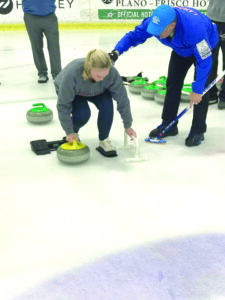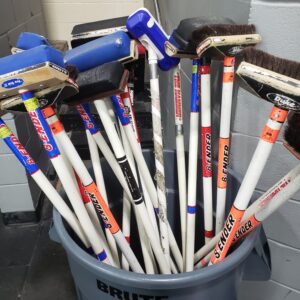By David Mullen
Justin Donaldson came to town alone. He had no friends in the area. But rather than being left out in the cold, Donaldson decided to turn to a Winter Olympics sport to find new pals. Not only did he meet plenty of people, but he also found two soulmates.

Photos by David Mullen
First, Donaldson fell in love with curling. Then he fell in love with Allie.
“I knew a little bit about it back in 1998 because of the Nagano Games,” Donaldson, 37, said, “But my first exposure was playing the Olympic Winter Games on Nintendo 64 and curling was on there. I said, ‘What the heck is this crazy sport?’”
With coverage of the Beijing Winter Games beginning on Wednesday, Feb. 2 on the networks of NBC, for three weeks the Winter Olympics will be channel-clogging TV. Unlike speed skating, alpine ski jumping or downhill racing, curling is the one televised Olympic sport that even the most experienced couch potato might jump up and say, “I can do that!”
“It’s a lot harder than it looks,” Donaldson said.
Donaldson grew up in western Maryland near Fredrick, studied civil engineering at Virginia Tech and moved to Dallas to pursue a career in forensic engineering. “It’s forensics for buildings,” Donaldson said. “Most of our work comes from insurance companies and litigation. I have a particular expertise in roofing.” It is surprising that CBS has yet to develop a series called “CSI: Office Park.”
“I moved here in March 2007, and I didn’t know a single person in the area,” Donaldson said. “I had no family, no friends, nothing. No ties whatsoever. Being an engineer, I am a rather introverted person and wasn’t having a lot of success meeting people.” His loneliness led to action, and he got what he said was “a wild idea.” After watching Olympic curling on TV from Nagano, he said to himself, “I wonder if this is something I can do to meet people.”

In 2008, he found DFW Curling Club, operating out of Mansfield. He was 55 miles away living in Frisco, which is hardly a stone’s throw to be introduced to live curling for the first time. He revisited the club’s website after the 2010 Vancouver Games and found the club was now curling out of Farmers Branch. “I said: ‘Hey, that’s way closer to where I live. I can do this.’”
He took an introductory course and remembered the throng of people who showed up because of their exposure to the sport from TV. “They weren’t ready for the huge number of people that showed up wanting to learn to curl,” Donaldson said. “I got to throw one or two stones and that was it. But it was enough to sell me on it.”
Donaldson joined the club, signed up for a team and has been playing ever since. “I’m not going to say I was some phenom, but the game came easy enough and I wanted to do it more. It felt like something I could pursue.” He began to make friends and associating with more established curlers and members of the club board.
“The club is not enormous, probably about 100 members,” Donaldson said. It was even smaller when he joined. “I was asked if I would run for a board position. It is all volunteer and hard to get people to serve.” After serving as special programs director, Donaldson is now president of the DFW Curling Club. “In all honesty, if you run for a board position, you are probably going to run unopposed.”
Donaldson’s second life-changing experience came when he met his future wife Allie through the club. “She had been curling for a few years. She was living in New Mexico [coming out of a relationship], knew someone in Dallas and knew we had a curling club. She blindly emailed me wanting to play in a tournament. She made friends with other people — not me so much because I am so introverted — but some people said: ‘You should look into Justin. He’s single.’ We started dating and got married.” They have a five-year-old girl.
Curling became an official Winter Olympics sport in 1998. Although popular in Canada, Japan and the Scandinavian countries, the beginnings of curling go back to 16th century Scotland. Some find curling akin to shuffleboard, but the curling lane (sheet) is made of ice and not played on cruise ships.
Teams with four players slide 40- to 44-pound stones down a 146 to 150 feet long by 14.5 to 16.5 feet wide sheet of ice toward a target of concentric circles during an “end.” The sheet begins slick but is peppered before a match to become pebbled.
Stones can be curved — or “curled” — down the sheet, aided by a team of sweepers that “sweep the stone,” helping the path of the stone without touching it.
Points are accumulated by adding the closest stone to the target (and other stones depending on location) and the highest score for a game (when eight or 10 ends have been completed) wins.
Virtually every stone is made with granite from the Ailsa Craig, an island off the west coast of Scotland and finished by Kays of Scotland in Mauchline, Ayrshire. Curling brooms (or brushes) were once made of corn strands or horsehair but are now made with synthetic fabric. They are not available at Home Depot.
Physically, flexibility is a key to success in curling. Mentally, curling has been equated with chess. Most curlers are also board game enthusiasts.
Curling is noted for its superior sportsmanship. Opponents are congratulated for good shots or a strong sweep during a match. Unwinnable games are conceded. Unlike the NFL, there is no taunting penalty in curling. After a match, players gather for a postgame party called the “Broomstacking.” Longtime member and Dallas resident James Holley said, “It’s like our 19th hole, but winners buy the beer for the losers.”
Dues are $50 per year, which includes membership in USA Curling. Teams pay separately for ice time. League competitions are held on Thursday evenings and Sunday afternoons at the Children’s Health StarCenter at Valley Ranch.
Like Donaldson, other DFW Curling Club members will tell you their interest is spawned by watching the Winter Olympic on TV, not from participating in the sport as a youth. Many local curlers learned the sport later in life.
They don’t all come from Moose Jaw or Medicine Hat. They come from places like Houston, Seattle, Denver, Charlotte and Raleigh-Durham. Scott Crawford moved here from Indianapolis. “When I was looking at job transfers, one of my criteria was if they had a curling club,” Crawford said, who participated in organized curling in Indy. “And when I saw an opportunity to transfer, I checked and saw that Dallas had a curling club and I said ‘OK. I will apply for that job.’”
The DFW Curling Club is a 501(c)(3) nonprofit private foundation that began in 2002. Throughout March, the club is offering public “Learn-to-Curls” for $40. Registration can be found at dfwcurling.com. The event is designed to introduce new players to the sport.
One might even be introduced to a few new friends, as well.
